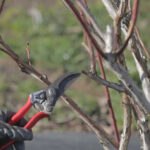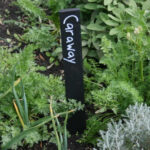If you’re looking for an easy-growing fall crop, growing carrots might be the way to go. These root vegetables can be sown in early September for a November harvest in most milder climates, and another crop started in the early spring!
Long considered to be the favored food of rabbits because of their portrayal in cartoons, carrots are rich in beta-carotene and vitamin A, as well as a slew of other great nutrients we need to survive. Ironically, rabbits often don’t eat carrots in the wild as they’re also rich in natural sugars!
But we certainly love our carrots. Whether harvested while young and tender or allowed to build up to its full size, carrots are a great addition to a healthy diet, and with the right soil and care are easy to grow in the garden.
Besides, what can be better than your kids clamoring to eat the carrots they planted themselves? They’re a win-win vegetable and a must-grow! Even if you’re relegated to small spaces, some of these varieties grow just as well in containers like Root Pouch grow bags, or Air Pots stocked in our store.
Let’s go over all the facts you’ll need to know to get a great crop of carrots this year and for years to come. You’ll love the taste of your own home-grown produce, and it makes for a perfect entry-level crop for most newbie gardeners.
Listen to this post on the Epic Gardening Podcast
Subscribe to the Epic Gardening Podcast on iTunes or Spotify
Good Products To Eliminate Carrot Pests And Diseases:
Carrots Overview
| Common Name | Carrot |
| Scientific Name | Daucus carota subsp. sativus |
| Germination Time | 14-21 days |
| Days to Harvest | 58-120 depending on variety |
| Light | Full sun |
| Water | 1” per week |
| Temperature | 60-75 degrees optimal range |
| Humidity | Prefers dry greens, can develop fungal diseases |
| Soil | Well-draining, loamy sandy soil is best, avoid overly-rich soils |
| Fertilizer | Fertilize with slow-release 10-20-10 prior to planting, do not overfertilize |
| Pests | Aphids, wireworms, flea beetles, root knot nematodes, leafhoppers, carrot rust fly, carrot weevils |
| Diseases | Bacterial soft rots & leaf blights, downy mildew, alternaria leaf spot & black rot, cercospora leaf blight, cottony soft rot, damping off, crown rot, fungal cavity spot, botrytis cinerea, powdery mildew, downy mildew, aster yellows, some mosaic viruses (cucumber, celery, alfalfa virii) |
Recommended Carrot Varieties
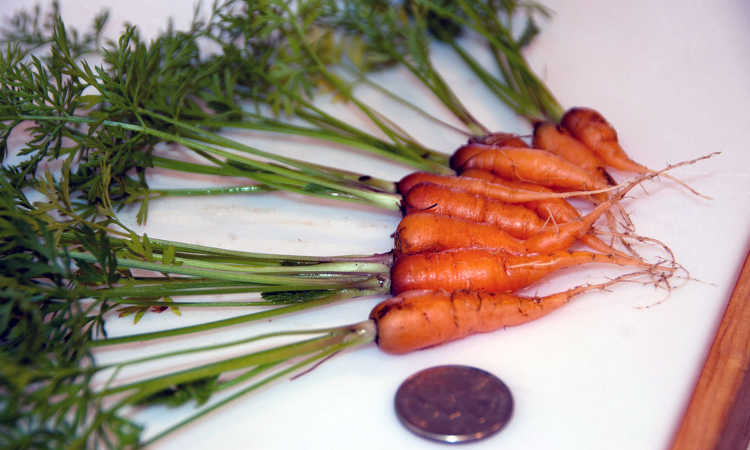
When selecting a carrot plant to grow, you’ll find that the real difficulty is deciding what variety you want. All edible carrots are the same species, Daucus carota subsp. sativus, and have been cultivated over centuries to reduce the natural bitterness of the wild carrot root.
Originally, most carrots weren’t the familiar orange hue that we know and love today. White, yellow, red, and even purple carrots have existed for longer than the orange ones. However, the orange ones often are some of the sweetest varieties, and are often commercially grown.
Some varieties are meant for planting in the ground. Planting carrots in a pot is popular too, and often happens with Chantenay or Ball-type carrots!
While the greens are technically edible, they’re often ignored in favor of other greens. They have a distinctive, slightly-bitter flavor and it’s something that you must become accustomed to before it tastes “good”.
There are five basic carrot shapes/sizes.
- Danvers: Most common, and what most people think of when they envision a carrot. Common commercial variety.
- Nantes: Slightly shorter than a Danvers and with a rounded, blunt tip. Easy to harvest.
- Imperator: Large carrots that make up most commercial growth. Extremely fast growing, fatter and sweeter than other types.
- Chantenay: Shorter carrots meant for container gardening or rocky soil. Rarely get much longer than 5-6″ in length.
- Ball: Literally shaped like a ball or an oval, these are about the size of a large radish and are extremely quick to form.
Carrots By Their Color
There’s a bunch of different colorations of carrots. Let’s sort through them by their normal coloration!
Orange Carrots
| Name | Days To Maturity | Description | Where To Buy |
| Napoli | 58 days | Sweet in fall, slightly less so in the spring. Up to 7″, blunt-tipped, early Nantes type. Perfect for overwintering. | Buy Seeds |
| Little Finger | 65 days | Only 4″ long and about an inch thick. Smooth skinned, small core. Great when roasted whole or for snacking. | Buy Seeds |
| Atlas | 70 days | Ball type carrot, 1.5-2″ diameter. The resulting radish-sized carrots are great for snacking! | Buy Seeds |
| Red-Cored Chantenay | 70 days | 5 1/2″ in length, golden-orange color, blunt tip and vitamin-packed. Beautiful smaller carrot type. | Buy Seeds |
| Muscade | 70 days | North African variety with blocky, bright orange roots and grow to 7″ long. Late-bolting. | Buy Seeds |
| Baltimore | 75 days | A smaller container-growing carrot at an average 6″ in length, this Nantes-style orange carrot is superb. | Buy Seeds |
| Danvers 126 | 75 days | The most common commercially-sold carrot on the market. Orange heirloom dating back to 1886. | Buy Seeds |
| Merida | 80 days | Great overwintering carrot. Plant in Oct/Nov, harvest in the spring! 6-7″ long, pale orange color. | Buy Seeds |
| New Kuroda | 90 days | Up to 7″ in length and 2″ in diameter. Bred for sub-tropical regions, with high tolerance to heat & leaf blight. | Buy Seeds |
| Oxheart | 90 days | Very old heirloom Chantenay variety, with 5-6″ fat roots that can weigh up to a pound each. Tolerates heavy soils. | Buy Seeds |
Yellow Carrots
| Name | Days To Maturity | Description | Where To Buy |
| Solar Yellow | 63 days | Pale yellow, with a sweet flavor. 6-7″ long, Danvers-type. Good for juicing. | Buy Seeds |
| Yellowstone | 73 days | 6-8″ long carrots with deep yellow roots. Blunt tipped carrot variety. Vigorous tops. | Buy Seeds |
| Jaune de Doubs | 75 days | 16th century heirloom from Europe. Yellow to light orange, great production, popular flavor. Great for storage. | Buy Seeds |
| Lobbericher Yellow | 80 days | Heirloom feed carrot, brilliant yellow in color and growing up to 10″ long. Good flavor! | Buy Seeds |
Red Carrots
| Name | Days To Maturity | Description | Where To Buy |
| Nutri-Red | 70 days | Imperator-type that’s loaded with lycopene and is a vibrant salmony-red color. Reaches 9″ in length. | Buy Seeds |
| Atomic Red | 75 days | Brilliant lycopene-loaded red carrot that grows up to 10″ long tapered roots. Great for kids and adults alike. | Buy Seeds |
| Pusa Rudhira | 90 days | Indian variety, extremely high in beta-carotene and lycopene. Excellent for juicing. | Buy Seeds |
| Scarlet Wonder | 120 days | Japanese kintoki-type or sweet red carrot, 12-14″ tapered roots. Fantastic for late fall/early winter harvesting. | Buy Seeds |
Purple Carrots
| Name | Days To Maturity | Description | Where To Buy |
| Cosmic Purple | 58 days | Purple on the outside, yellow-orange inside! 7-8″ long and visually stunning in salads. | Buy Seeds |
| Black Nebula | 70 days | Bred for home gardeners, this variety is so dark purple it’s almost black. Best picked at 4″ lengths. | Buy Seeds |
| Purple 68 | 75 days | Purple exterior, purple core, and a ring of white within. Another visually stunning dark carrot. | Buy Seeds |
| Purplesnax | 75 days | Super-sweet, popular purple-exterior carrot with a mellow orange center. 8-9″, straight-growing, narrower than many types. | Buy Seeds |
| Gniff | 130 days | Slow-growing purple-skinned carrot with a white center. Traditionally pickled, and great for storage. | Buy Seeds |
White Carrots
| Name | Days To Maturity | Description | Where To Buy |
| Kuttigen | 70 days | Broad-shouldered creamy white carrot with a tapering tip. Extremely old heirloom variety. | Buy Seeds |
| Blanche a Collet Vert | 75 days | 12-24″ long white feed carrot with green shoulders. Less sweet than most modern carrot types. | Buy Seeds |
| Lunar White | 75 days | Moon-white carrots that stand out from other varieties, with mild and delicious flesh. 6-8″. | Buy Seeds |
| Snow White | 75 days | Pure white, 7-8″ long carrot with a mild, sweet flavor. Excellent quality roots. | Buy Seeds |
Planting Carrots
Listen to this post on the Epic Gardening Podcast
Subscribe to the Epic Gardening Podcast on iTunes or Spotify
The process of growing carrots is actually rather simple. Let’s go over some tips for growing carrots by discussing how to plant carrots from seed, and then we’ll dive into the more esoteric questions afterwards.
When To Plant Carrots
It takes about 12 weeks for most varieties of carrots to reach maturity, but most gardeners can get two crops per year: one started in the spring, and one in the fall.
Before you plant, consider how long the weather will be optimal for growing carrots. If the soil is too cold, they will slow down their growth, conserving their natural sugars to sustain the plant through the winter months. Also, frost is a real risk to carrot greens.
Heat is equally difficult, as too-hot temperatures can cause your carrots to go to seed in a frantic effort to propagate themselves. Once the seed stalk starts to rise, the carrot’s root is going to be unpalatable and woody.
Aim for early spring planting after the risk of frost has ended, or early fall planting before the colder temperatures set in. In areas where the summer doesn’t regularly get over 85 degrees, you can grow carrots throughout the spring and summer months by planting every 2 weeks.
Where To Plant Carrots
Carrots need loose soil to form nice, straight roots. Soils that are compacted or are heavy clay composition tend to be difficult to grow carrots in, simply because the roots will become misshapen during the growth process. Sandy, loamy soil is best. Avoid rocky soils.
As carrots can grow to reach 10-12″ in length, you’ll need to loosen and aerate the soil about a foot deep for optimal growth. If growing in a raised bed, this can be very easy to do, but if you’re growing in the ground, be sure to till or break it up as needed.
Sandier soils tend to be easier to grow carrots in, simply because they are well-draining and easy for the roots to penetrate. However, any good potting mix will work quite well, provided that there’s no stones.
You will want a location that gets nice and sunny, as the carrot tops will need full sunlight once they’re matured beyond 3-4 inches in height. Prior to that, partial shade is good to allow the young tops to develop and firm up.
I’ve successfully grown carrots in a deep raised bed before and had no problems. Planting carrots in pots work just as well if you don’t have a garden plot already set aside. As long as there’s at least 6-8 hours of sunlight per day for your carrots, they can be placed nearly anywhere!
If you’re growing carrots in pots, be sure that they’re deep. A planter box that’s at least 14″ deep and a foot wide (by whatever length you’d like) is a great way to get a single row of carrots. A two-foot wide planter box will give you two rows of carrots spaced at least a foot apart.
How To Plant Carrots
Create rows that are at least 1-2 feet apart, and plant seeds a half-inch deep, spaced 1-2″ apart. Once the carrot tops have reached 4″ in height, thin them to 2″ apart, keeping the strongest plants intact. You might discover that you have some tender baby carrots to eat while thinning!
Each foot of row space will provide about a pound of fully-grown carrots when it’s time to harvest. If you want to stagger planting to harvest continuously throughout the spring and summer months, plant a new section in the carrot garden every two weeks.
Be sure to religiously remove any weed growth, especially while your plants are small. Weeds will steal the nutrients your carrots need to develop and compete with the roots for space. While they can tolerate some weeds when they’re larger, it’s still best to avoid weed growth.
It takes 14-21 days for carrot seeds to germinate, and they’ll need consistently moist soil during that time period.
Growing Carrots
Provided that the conditions for your carrots are optimal, you’ll have a plentiful supply of these nutrient-rich root vegetables for your table! Let’s explore the list of perfect conditions for growing carrots so you know exactly what to do.
Sun
When your carrots are seedlings (less than 4″ tall), the thin carrot tops are less tolerant of heat and direct sun. During this time period, supply some shade cloth that allows some sunlight to penetrate but which reduces the intensity. 50% shade cloth is perfect.
Once they’ve reached 4″ or taller, slowly accustom them to full sun conditions. They will quite happily thrive in 6-8 hours of sunlight once the greens are established.
Temperature
The perfect temperature range for growing carrots is between 60-75 degrees Fahrenheit. However, once established, they can tolerate conditions almost into the 90’s. Much hotter than that and they will start to bolt to seed, making the roots bitter and unpleasant-flavored.
If you’re planning on growing carrots in the spring, you should be able to have optimal temperature conditions for much of that season. Once the summer months begin to heat up, it may be best to provide some light shade during the hottest part of the day to keep them cooler.
In areas where hard frosts are common, your fall-started carrots can be much sweeter than you’d expect! A hard frost can signal to the carrot that it needs to store sugar in its roots to sustain the plant. Put 18″ of loose mulch over the carrot bed to protect the roots until you harvest.
Watering

How much water do carrots need? Carrots require about an inch of water per week to develop thick, plump taproots. However, keeping the soil consistently moist is the key. You can opt to water in short bursts using a drip system to keep them well-hydrated.
Shredded leaf mulch can also help reduce the need for additional watering, as it helps prevent evaporation of the soil moisture. I recommend a few inches of mulch throughout most of the year, plus a thicker layer in the winter months if you’re leaving some for later harvest.
I prefer to use a soaker hose along my carrot rows because it prevents moisture from getting on the carrot greens. If they’re consistently wet, fungal diseases will develop, and it’s best to avoid those from the start.
Soil
The most important part of growing carrots is ensuring that you have the right soil.
If your soil is too rich, your carrots will have the tendency to fork or develop hairy roots. While they’ll still taste good, they’ll look very strange, and they can be very hard to peel if you plan on peeling them.
Rocky soil is also an issue, as the rocks also prevent straight root development. It’s a good idea to dig out twelve to eighteen inches deep in your beds before planting and sift out any large rocks. Amend the soil if needed to reduce any compaction or clay-like tendencies.
Ideally, your soil will be a sandy loam, well-draining but able to retain enough water to sustain your plants, loose and well-aerated prior to planting. Keep the pH around 6.0-6.8 for the sweetest carrots, although they can grow in conditions ranging from 5.5 to 7.5.
Fertilizing
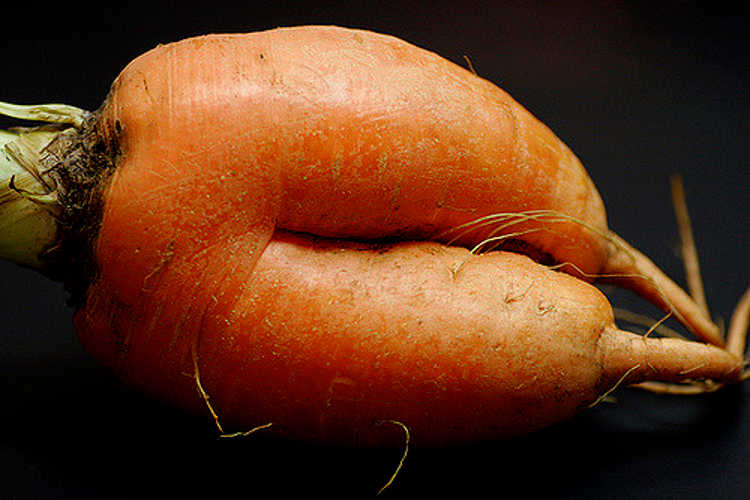
When growing carrots, fertilizer is a bit tricky. You will want to amend your soil before planting with a slow-release 10-20-10 fertilizer to promote good root growth, preferably an organic one. But too much fertilizer is a problem.
Just like rich soil, fertilizer can cause your carrots’ roots to fork and grow hairy root systems. You can get some very oddly-shaped produce that way, so it’s not recommended. One single pre-planting fertilizer addition should be plenty of nutrition for good growth.
Propagation
Carrots are grown from seed, and that’s the only way to successfully get produce. While it’s possible to regrow carrot greens from a cut-off segment of the top of the carrot, the main taproot (the carrot itself) will not regrow.
When a carrot plant bolts in the warm weather, you can allow the top to develop seeds and dry out. You can then harvest the tiny seeds from within the pods once they’ve formed. However, it’s often much easier to simply purchase carrot seeds of reliable strains, as they germinate well.
Transplanting
It’s not advisable to transplant carrots if you can avoid it. Since the produce is the main taproot of the plant itself, any disturbance once planted can cause irreversible damage to the root structure.
If you must transplant, start your carrots in pots that are about 5″ tall and narrow. 6″ tall is even better. When the greens have reached 4″ in height, carefully transplant the entire contents of the pot without disturbing the soil around the root.
Pruning
Carrot tops do not require pruning during the growing season, but do require monitoring to make sure that they’re not bolting to seed. As long as the temperature is cool enough, your carrots will handle themselves quite admirably without your help!
Harvesting and Storing Carrots
Determining when to harvest the carrots may be the most complicated portion of the growing process. You don’t want to disturb them too early, but you also don’t want them to freeze solid! Here’s some tips on harvesting and ways to store them once they’re brought indoors.
Harvesting Carrots
Baby carrots can begin to be harvested roughly 50-60 days after planting. These will be slender carrots, and the top of the root should just be barely visible above the ground.
If you want better storage carrots or larger ones, wait for a while longer. Depending on your variety, most full-sized carrots will be ready at 70-80 days after planting, although it can be up to 90 days or longer for a few types. The top of the root should be quite visible at harvest time.
When harvesting, it’s best if you avoid grabbing the plant by the greens, as it may just break off in your hand and the root will still be underground. Instead, use a hand trowel or garden fork to loosen the soil around the carrot and then grasp the top of the root itself.
Harvest only enough carrots to use in a 2-4 week period of time if you’re not expecting a hard freeze in the near future. Carrots can remain in the soil for a month or more after their earliest harvest date.
When the weather begins to threaten to freeze the ground solid, make sure any last carrots are harvested prior to the freeze. This prevents damage to the root while allowing you to extend your in-ground period for a little while longer.
Spring carrots should be harvested at or shortly after their harvest date, especially if the weather is particularly warm. If they’re in the ground too long, they may bolt to seed. This causes the root to become woody and unappetizing, also giving it a bitter flavor.
Storing Carrots
Avoid storing your fresh carrots near apples, pears, or other fruits which produce ethylene gas while stored. This odorless gas can cause the carrots to deteriorate much more rapidly, reducing your storage time.
To store your carrots, remove the carrot greens close to the root itself. Wash and dry the carrots, making sure that the surface is completely dried, and then store them in the vegetable bin in your refrigerator.
You can store carrots in a plastic bag if you wish, but make sure that either there is a ventilation hole in the bag or a layer or two of paper towel inside to absorb any excess moisture. The goal is to keep your roots dry and cold until use.
If you have access to a root cellar, you can place your carrots into a bucket of clean, barely moistened or dry sand in the root cellar. They will last there for several months’ time, although you will need to dig out your carrots occasionally to check their status.
Preserving Carrots
There are many ways to preserve your carrots for longer use!
One of the most popular methods is to slice and dehydrate them, as they easily rehydrate in soups and stews later. Carrots have a surprising amount of moisture, so you should expect the resulting dehydrated carrot pieces to be much smaller once fully dried.
Freeze-drying also works quite well for storing your carrots. This works especially well for people who want to make carrot crisps. The freeze dryer does an excellent job at extracting the moisture and providing you with a crispy end product that will last well in bulk dry storage.
If you have freezer space, dicing or slicing your carrots into your preferred shape and freezing them will work very well. Place your dry, prepared carrots in a single layer on a pan and place into the freezer until they’re frozen solid. You can then transfer them to a freezer bag.
Got a juicer you want to use? Make and freeze carrot juice! The pulp can go into the compost or be fed to chickens, and the juice works well on its own or in soups when thawed.
Carrots are an excellent addition to a jar of pickled vegetables, and you can of course pickle them alone as well. These are a refreshingly different flavor when eaten later, and a nice break from a standard cucumber pickle!
And finally, carrots can be canned, but it requires a pressure canner. These are a low-acid food and should not be canned in a water bath canner.
Troubleshooting Carrot Problems
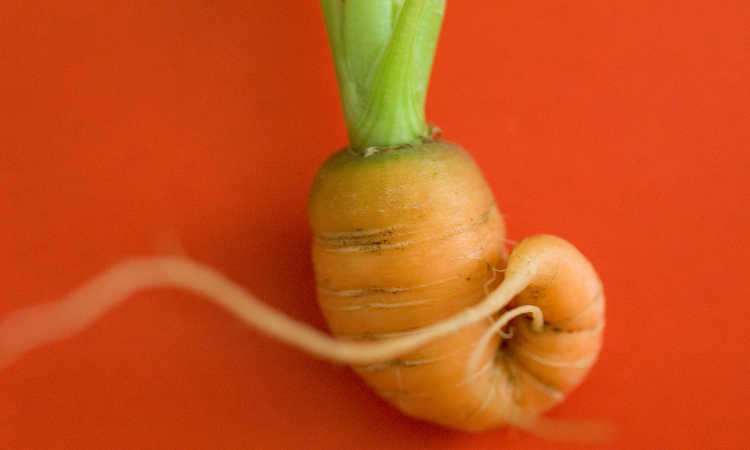
Listen to this post on the Epic Gardening Podcast
Subscribe to the Epic Gardening Podcast on iTunes or Spotify
While carrots are reasonably easy to grow, they’re also some of the most finicky in terms of conditions. In addition, a number of pests and diseases can impact your carrot crops. Here’s a list of ways to deal with some of the most common carrot problems that might arise.
Cold-Based Growing Problems
Are your plants bolting quickly and trying to set seed? It is quite possible that temperatures below freezing in the early spring are causing it. Young plants that were started too early may panic and try to propagate before they die out. A cold frame will help warm them up.
Carrots that are pale in coloration at harvest are experiencing symptoms of being cold, too. If the average air temperature is below 65 degrees, the carrots that develop will be pale and may not be as flavorful as warmer roots. Add a thick layer of mulch or a cold frame.
Heat-Based Growing Problems
Just like cold conditions, heat can cause your carrots to bolt quickly and try to set seed. However, it’s harder to slow down that process. Harvest before extreme heat sets in whenever possible. Provide shade during the heat of the day to cool down the plant temperature.
Are your carrots bitter? Too much heat prevents sugar development in the roots. Mulch heavily around the base of the plant to reduce the soil temperature and provide a little extra shade during the hottest time of day.
If your young carrots are emerging in clusters or not emerging at all, this may be a sign of excessive soil heat. Too hot conditions can prevent germination entirely. Your seed may also be sown too shallowly, and adding an inch of finely-sifted aged compost can help that.
Water-Based Growing Problems
Are cracks developing along the length of your carrots? That’s a sure sign of inconsistent soil moisture. If your carrots’ watering is feast or famine, and they alternate between wet and dry conditions, they’re prone to cracking.
Keep the soil evenly moist and add mulch to slow down evaporation if cracking happens. This can also be a sign of carrots overdue for harvest. On the bright side, they’re still edible even if cracked, so it’s not a complete loss.
If your carrots are starting to rot or are developing enlarged white spots on the roots, this is a sign of overwatering. It’s also a sign of possible fungal disease in your soil. Remove and destroy any carrots showing these symptoms.
Soil-Based Growing Problems
Has it been a while since you planted your seeds, and yet seedlings are failing to emerge? Your soil may have crusted on its surface. Keep it evenly moist to prevent that hardened crust, and avoid overhead watering which can cause that crust to form.
Harvesting should bring you nice, straight carrots. But if your carrots have hairy roots or are forked, it’s usually a sign of overfertilized soil. Slow down on your fertilizer use. Direct contact with fresh manure may also be to blame, and you should avoid that when possible.
Does your carrot look deformed, or has it split to become an alien mutant carrot? Forked carrots or twisted ones can be caused by over-rich soil, but as commonly occur from blockages in the soil. Carrots grow around rocks or other obstacles and can be deformed as a result.
Ensure your soil is rock-free and is well-aerated to reduce compaction. If necessary, amend clay-like soils to make them looser and easier for the roots to penetrate.
Other Growing Problems
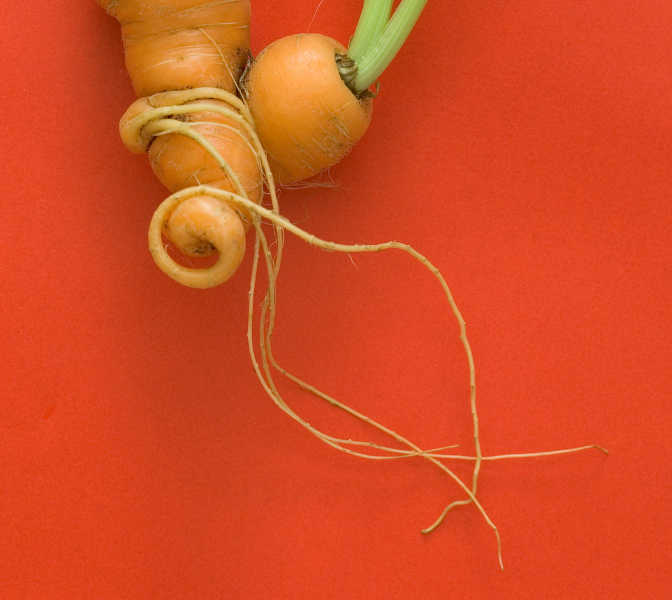
Look at where the carrot greens meet the root. Is the top of the root green? If so, it’s been exposed to direct sunlight and chlorophyll has started to be stored in it. To avoid, cover your root tops with mulch to prevent direct sun exposure, or let the greens provide total shade.
Carrots which look like pencils or which are thin and spindly may be competing with weeds for their nutrition needs. It’s important to remove weeds as soon as they appear in your carrot beds. Don’t plant your carrots close to other plants for the same reason.
Are you experiencing a bad case of cuddling carrots? If your carrot roots are twining around each other, you forgot to thin them out. Once they’ve started to intertwine it’s hard to separate them, so don’t forget to thin them to 2″ apart when they’re small.
Pests
Quite a few pests can strike at carrots, but some are very specialized and go after carrots exclusively. As you can imagine, this can be a real problem! Let’s look at some of the pests which might strike, both common and uncommon.
Aphids, particularly the willow-carrot aphid (Cavariella aegopodii), are prone to feed on the carrot greens. These aphids also can produce young in the soil which may attack your carrot roots, and they are vectors for disease spread. Use neem oil to eliminate them quickly.
Wireworms, the larvae of click beetles (Elateridae spp.), are another major issue. So too are the larvae of the dreaded flea beetle (Systena blanda). And a variety of pest nematodes including root knot nematodes can also take up residence in the soil.
For both wireworms and flea beetle larvae as well as the root knot nematodes, battle these soil-dwellers in the soil itself. Use beneficial nematodes to eliminate the larvae or root-knot nematodes. Adult beetles can be sprayed with a pyrethrin spray.
Leafhoppers are the last of the more common pests to strike carrots. Like aphids, these are vectors for disease spread, and they also suck the juices out of the plant’s greens. An insecticidal soap will help to keep these at bay.
Finally we come to the pests which are carrot-specific.
The carrot rust fly (Psila rosae) lays eggs in the soil, and their larvae burrow into the roots and leave rot in their wake. It’s best to prevent these with floating row covers whenever possible, but a pyrethrin spray can also kill them off.
Carrot weevils (Listronotus oregonensis) will also chew gaping holes through your roots, and a liquid form of bacillus thurigiensis (BT) can be used to kill them off in the soil. They also can be eliminated with the use of neem oil, although this process will take longer.
Hot Water Treatment For Carrot Seed Diseases
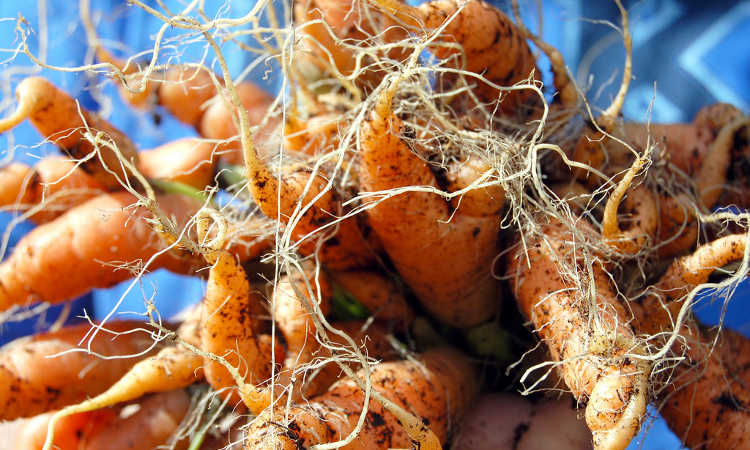
Many bacterial, microbial, and fungal diseases are carried into your garden by infected seed. A hot water treatment of the seed prior to planting can disinfect your seed and may prevent disease spread.
To treat your seed, begin by soaking your carrot seeds in warm water (about 100 degrees Fahrenheit) to remove any air and pre-warm them. This should be done for about ten minutes.
Using a thermometer to carefully maintain the right temperature, prepare some 122-degree water. This will be just hot enough to sterilize the diseases, but will not kill off the seeds themselves.
Once your seeds have been pre-warmed, transfer them into the 122-degree water for 20 minutes, making sure that the temperature remains right at 122 degrees for the entire time. When they’ve hit their time limit, quickly transfer the seed into cold water to stop the heat treatment.
If you wish to add an anti-fungal powder coating to the surface of your seeds, this is the right time to do so. Once that’s done, spread your seeds out on a flat surface to fully dry. If you opt to skip the powder coating, then just spread the seeds out to dry.
Carrot seeds are very tiny, so it helps if you use a fine strainer or place your seeds into a fine-meshed cheesecloth to do this heat treatment. You need the hot water to reach all of the seeds to sterilize any bacteria or fungi on their surface, so it is easiest to do this in small batches.
Bacterial or Microbial Diseases
Bacterial diseases often develop if the weather is warm and there’s a lot of humidity around your plants. These conditions make it more likely that bacteria in your soil will make it into your produce. It can also continue to thrive in plant debris, so maintain a clean garden.
A number of bacterial soft rots (Erwinia carotovora, Erwinia chrysanthemi, and Pseudomonas marginalis in particular) can strike carrots. These turn the carrot root to mush, softening it so the bacteria can feed and leaving the outer skin of the carrot intact.
There are no treatments for bacterial soft rot once it occurs, so you’ll need to dispose of all affected plants. The bacteria may remain in the soil for a while afterward and prevent you from further planting, but solar sterilization by super-heating the soil can kill it off if done properly.
Bacterial leaf blight (Xanthomonas campestris) is also a risk. This causes brown spotting on the carrot leaves, often surrounded by a yellowish halo. A sticky, amber-hued goo may also be visible oozing down from the leaves and is exuded by the bacteria.
This particular blight is usually seed-borne, and so your best bet to avoid it is to purchase seeds from reliable sources that are bacteria-free. You can also be able to do a hot water seed treatment to kill off Xanthomonas bacteria on home-grown seeds.
Downy mildew (Peronospora umbellifarum) is a disease caused by oomycetes, a form of microbe. While it colonizes similarly to the fungal powdery mildew, it produces a darker spore and can rapidly spread through your carrot greens, causing damage to the foliage.
I prefer to use a copper-based fungicide such as Monterey Liqui-Cop to treat downy mildew when it surfaces, but neem oil is a good preventative.
Fungal Diseases
A number of fungi also wreak havoc in your carrot beds. Let’s go over some of these.
Two different alternaria fungi cause two different forms of damage. Alternaria dauci causes carrot leaf spot, and alternaria radicina can cause black rot on the roots before and after harvest. Treatment with a liquid copper fungicide such as Monterey Liqui-Cop is advised.
Another leaf blight is caused by cercospora fungi. The cercospora leaf blight looks very similar to the alternaria leaf blight, and treatment with Monterey Liqui-Cop is also recommended for this particular blight issue.
Sclerotinia sclerotiorum causes what’s called cottony soft rot. Also called white mold, this disease creates white, cottony masses at the top of the root, and can cause a distinctive soft, liquidy rot in the root mass. This is a complicated one to combat as few organic measures treat it.
One thing which is becoming more common in the fight against cottony soft rot is a beneficial fungus, Coniothyrium minitans. This fungus can prevent development of the cottony soft rot and protect your carrots when combined with good crop rotation techniques.
Rhizoctonia fungi can cause two different symptoms. In newly-sprouted plants, it can cause damping-off. In older plants, it causes the plant to develop crown rot. Both are typically caused by Rhizoctonia solani, a common culprit in the home garden.
The usual culprit for Rhizoctonia development is warm, overly-wet soil or foliage. If your soil is holding too much water, this may become a recurring problem. Provide good airflow around your plants and ensure your soil is well-draining.
Pythium fungi causes damping off in new carrot seedlings and fungal cavity spot in older ones. It often occurs in conjunction with Rhizoctonia fungal growth. Unfortunately, it’s also quite destructive when it occurs, and crop rotation doesn’t help.
This fungi is spread through flowing water, and so it’s important to provide well-draining soil and to avoid splashing of soil particulates onto the carrot tops. Using a soaker hose to water with is generally a safe choice. There is no treatment other than destroying infected plants.
One other form of damping off is spread by Fusarium fungi. Also known as fusarium wilt, it has very few treatment solutions and can dwell in your soil for years. Thankfully, damping off is the only common effect that fusarium can have on your carrot crops.
Some mycorrhizal treatments have shown promising signs in reducing fusarium in the soil. Products like MycoStop may be an option for preventing fusarium development, and they can help with other fungi as well.
Botrytis cinerea is often referred to as grey mold, and it is relatively easy to treat as long as you catch it early in its development. Use a liquid copper fungicide such as Monterey Liqui-Cop to treat this condition.
Last on the fungal list is powdery mildew. While nowhere near as destructive to carrots as some of these other fungal diseases are, it can slow the plant’s ability to create chlorophyll, which can result in plant stunting. Regular spraying of neem oil will wipe this problem out.
Viral Diseases
When viral diseases strike, usually nothing can stop them. Infected plants will have to be destroyed. Often spread by aphids or leafhoppers, these can become extremely destructive, and eliminating the pests is your best means of protection.
The two most common viral diseases when growing carrots are aster yellows and mosaic viruses.
Aster yellows is caused by a phytoplasma, a form of bacteria. It’s distributed by leafhoppers and causes chlorosis (yellowing) of the carrot leaves, as well as causing leaves to grow stunted or to easily break off at the slightest touch.
Mosaic viruses can also strike your plants. Most commonly, the celery mosaic virus or cucumber mosaic virus are the most common in carrot crops, although the alfalfa mosaic virus is starting to impact carrots as well.
The majority of mosaic virii are transmitted by aphids. Like aster yellows, carrots infected by mosaic viruses should usually be destroyed. However, if the infection happens right before harvest, you may be able to harvest early and still consume the carrot root.
Carrots do have a lot of random problems, but once you’ve grown them once, you’ll never want to buy carrots at the supermarket again. What’s your favorite carrot variety? Do you prefer the exotic or the tried-and-true? Tell me about your carrot patch in the comment section!





